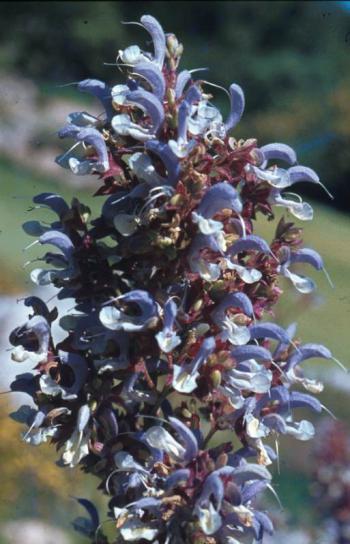Salvia chamelaeagnea
Salvia chamelaeagnea P.J.Bergius
Family: Lamiaceae
Common names: Rough Blue Sage, Bloublomsalie
Introduction
Members of the sage family are known worldwide as excellent herbs and beautiful garden plants. Salvia chamelaeagnea, which grows wild in the south western Cape, is no exception.

Description
Description
Salvia chamelaeagnea forms a dense shrub, growing almost 2 metres high, with many strong, upright stems. The stems are square- shaped, a typical feature of the family Lamiaceae. Leaves are formed opposite each other along the stems or on short side branches, and often grow in tufts. The bright green leaves are slightly hairy and sometimes the edges are toothed. The leaves are dotted with glands which emit a very strong scent when touched and leave a sticky, bitter-tasting residue on fingers.
The flowers are formed in whorls along the top third of the stems, any time between November and May. Individual plants flower for a month or two. The flowers are on small side branches; opening from the bottom upwards towards the tips of the stems. The large calyx is usually an attractive reddish-purple colour. It is covered with small hairs and is also dotted with glands. The corolla, which we usually call the flower, varies in colour from blue, mauve, pink to pure white. Flowers with a dark blue top lip and white lower lip are the most common.

Derivation of name and historical aspects
History
In southern Africa 22 Salvia species occur naturally, with most of them distributed through the south western Cape. Between 800 and 900 species of Salvia are found in the temperate and tropical regions of the world.
Ecology
Ecology
Flowering bright blue during the long hot summers, these plants are easy to find in the dry landscape where they grow along seepage areas, riverbeds and in sandy soil among rocks. Salvia chamelaeagnea is well adapted to survive fires, which regularly sweep though the fynbos vegetation, by resprouting from its woody rootstock.
The 2-lipped flower has adapted a very interesting shape for pollination. The bottom lip forms a platform for insects, such as bees, to alight upon while collecting nectar. The anthers and stigma, protected by the hooded top lip of the flower, protrude just enough for the hinged anthers to move down to deposit their pollen and the curved stigma to collect pollen from the back of a visiting bee.
Uses
Use
Like many of the other sages, Salvia chamelaeagnea is used for a wide variety ailments such as coughs, colds, diarrhea, colic, heartburn and flatulence. A tea, to be sipped slowly a few times a day, is usually made from the fresh or dried leaves and flowers.

Growing Salvia chamelaeagnea
Grow
Salvia chamelaeagnea is an evergreen shrub that is easy to grow, flowering in a range of colours through summer. With its upright growth and fresh green foliage it also provides texture contrast in a planting. For best results, these plants require full sun, well-drained, good garden soil and regular water, especially in winter.
The blue Salvia chamelaeagnea looks beautiful when flowering with blue agapanthus. The white form looks lovely mixed with other green foliage plants, giving the garden a fresh and cool look during the midsummer heat. Plants can be maintained in the garden for several years, but need to be cut back after flowering to keep them tidy and vigorous. Salvia chamelaeagnea can be propagated from seed or cuttings. Sow the seeds in spring in a seed tray filled with a well-drained medium. The young seedlings grow fast and can be planted into individual containers as soon as they are big enough to handle. They respond well to organic fertilizers and can be planted out as soon as the roots are nice and strong. The tips of the stems can be pinched to form bushy plants. Seedlings flower from a year to 18 months after sowing. To get a selected colour form it is best to propagate the salvia from cuttings. These can be made from the young shoots which form at the bottom of the plant in spring and early summer.
Credits
Liesl van der Walt
Kirstenbosch
January 2001
Plant Attributes:
Plant Type: Perennial, Shrub
SA Distribution: Northern Cape, Western Cape
Soil type: Sandy, Loam
Flowering season: Early Summer, Late Summer, Autumn
PH: Acid, Neutral
Flower colour: Blue, White
Aspect: Full Sun
Gardening skill: Easy
Special Features:
Horticultural zones











Rate this article
Article well written and informative
Rate this plant
Is this an interesting plant?
Login to add your Comment
Back to topNot registered yet? Click here to register.